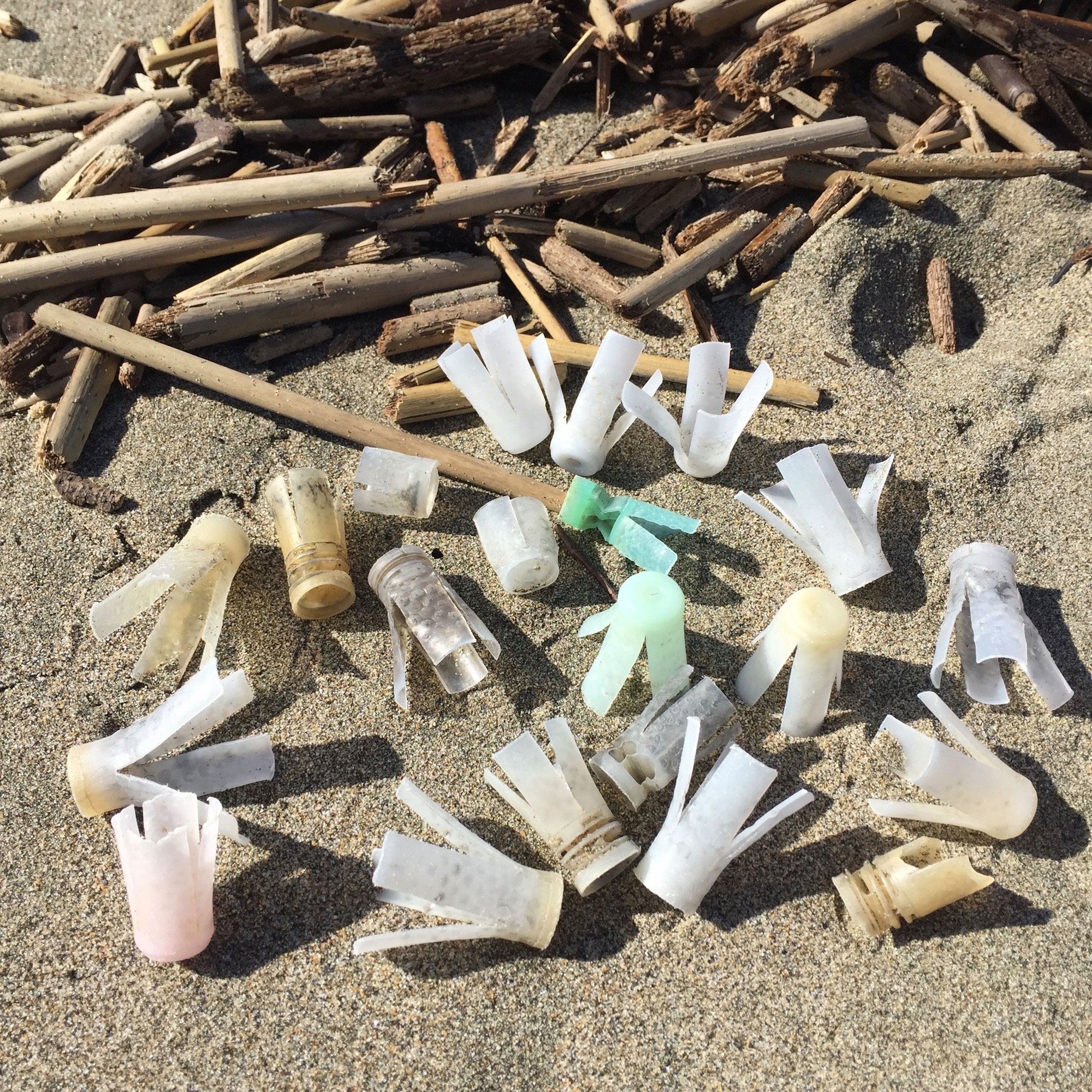
A Key Topic at the July California Coastal Commission
If you have participated in a beach clean-up with Surfrider, you may be aware that there are many unique items found as trash on our shores: cigarette butts, glow sticks, and even couches. What may come as a surprise is that one of the most prevalent findings during beach clean-ups on the Pacific Northwest coastlines are, actually, shotgun wads.
In fact, in one single beach clean-up you may come across thousands of plastic shotgun wads.
So, what are shotgun wads?
Shotgun Wads
Shotgun wads are often mistaken for the shell, casing or cartridge. Instead, they are small plastic wads (roughly containing the same amount of plastic as a grocery bag) which separate the shot from the gunpowder and holds the shot together inside the casing. Shotgun wads, also known as shot cups, have come in many iterations since the dawn of shotguns, from felt to cardboard. However, since the arrival of plastic, that has become the more commonly used material.
When a wad is shot, it soars downfield as far as 20-50 yards from the hunter’s location. When a wad lands in water and brush, it can make it impossible for even the best conservationist hunter to retrieve it. The plastic wads are carried into the San Francisco Bay through waterways, finding their home in our oceans and on our beaches. Roughly one billion shotgun wads are fired annually, leaving a gargantuan pile of plastic for the ocean to consume.
The good news is that technology and scientific inquiry have led us to better understand plastic and its many polymeric shapes, distinctions, and combinations. And as the world becomes increasingly aware of the problem plastic introduces to the environment, there are many organizations and companies – including Surfrider and Eco Shot – who are teaching others about biodegradable forms of plastic alternatives.

On July 10th of this year, Surfrider SF (Laura Walsh & Anna Kauffman) and the founder of Eco Shot (Andrew Thomas) met with the California Coastal Commission to discuss shotgun wads, the problems they pose, and cleaner solutions. For example, when ammunition manufacturers proposed new “compostable” shotgun wads, it was discovered they were largely made with PLA plastic which require a high-heat facility to break down. Not the typical weather of the Bay Area, let alone the ocean.
But, what about a different plastic?
Alternative Plastics
CEO Andrew Thomas at Eco Shot talked to the California Coastal Commission about Eco Shot’s goal to make 100% biodegradable shotgun wads using PHA plastic. Although it is still an emerging material and more testing needs to be done, PHA shows potential promise to degrade in the natural environment without the need of an industrial composting facility and some products have been TÜV OK Compost HOME certified.
PHA is also very dense, so when it gets in the water, it will sink. This can help prevent secondary wildlife interactions and increase degradation rates. And, it will be less likely to be washed out into the waterways towards beaches in, for example, San Francisco. Eco Shot and Surfrider SF hope to change the buying behaviors of hunters as well as move the needle on a policy-level in how we regulate plastics, bio-plastics and emerging alternatives.
Looking Ahead
Members from the California Coastal Commission seemed surprised to learn about the problem, though some were familiar whether they did research in the wetlands valley, had first hand experience finding plastic shotgun wads in their communities, or were hunters themselves.
Commissioner Mike Wilson from the California Coastal Commission spoke about how just during the weekend before the meeting, he had found 5-6 wads in Stone Lagoon. “They are everywhere you can think of because they float. If I had picked up those 5 or 6 wads and threw them out my car window, I would get a $1,000 dollar fine. There’s an expectation that this is OK.”
As far as policy, reform has previously come along for ways to make hunting environmentally responsible, such as when California transitioned away from lead shot to steel shot. While plastic is used now due to its malleability, versus the aforementioned felt or cardboard, there is still an opportunity to change the type of plastic in shotgun wads which could reduce the plastic pileup occurring in the Bay Area as well as up and down the Pacific and Atlantic coastlines. However, like the transition from lead to steel, those like Commissioner Wilson believe it will require legislation.
The fight for biodegradable wads is gaining momentum, and organizations like Surfrider SF and Eco Shot are spearheading the charge. The next steps are now up to the people to advocate for change.
Get Involved!
If you are interested in getting involved with Surfrider’s Shotgun Wad Watcher, or want to learn more on how you can help, you can contact Anna Kauffman (akauffman@sf.surfrider.org).
